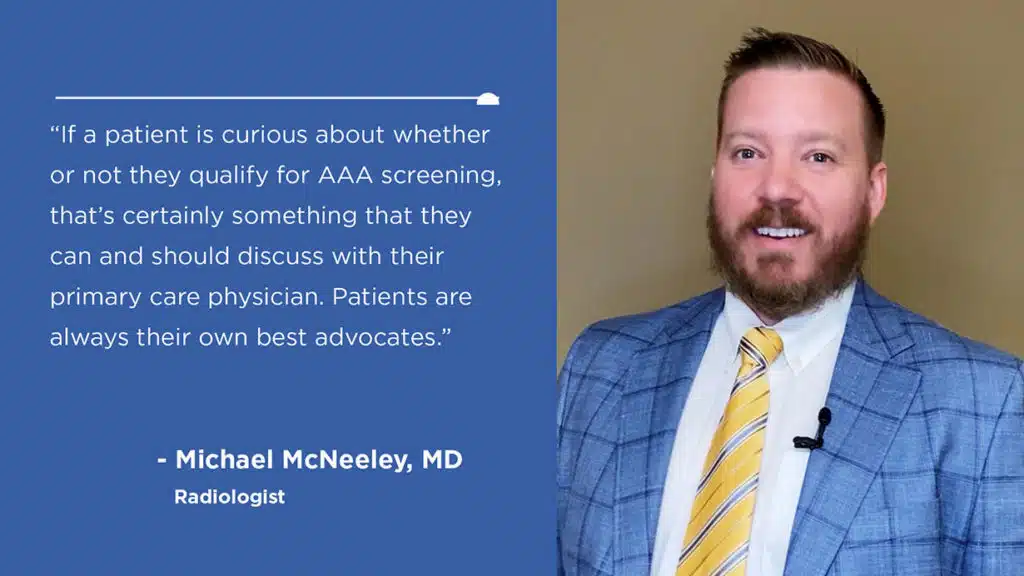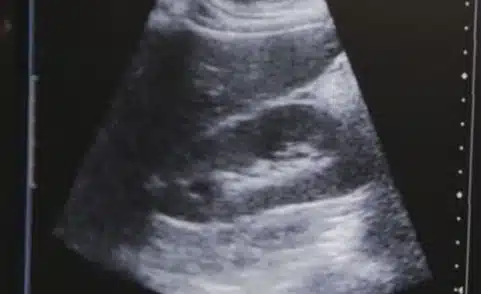
Your Aorta Is Important. Here’s How AAA Screening at RAYUS Radiology Can Ensure You’re Taking Care of It
If your arteries were a basketball team, your aorta would be the captain. It’s the largest artery in your body and does a lot of the work, carrying blood from your heart to your other organs and extremities.
And such an important player, needs to be in top physical shape. Ultrasound screening at RAYUS can identify warning signs for a potentially deadly problem called an abdominal aortic aneurysm.
What Is An Abdominal Aortic Aneurysm?
Essentially, it’s when your aorta becomes weak and bulges. Radiologist Michael McNeeley, MD compares it to a balloon. “As a balloon expands with air, the wall [of the balloon] is under increasing tension. And over a certain size, just as a balloon becomes prone to pop, the aorta has a tendency to become weaker. And eventually if it goes untreated long enough it can rupture, which would cause a massive hemorrhage and potentially death.”
Every year, 200,000 people in the U.S. are diagnosed with an abdominal aortic aneurysm, according to the Society for Vascular Surgery.
What Is The Purpose Of AAA Screening?
During ultrasound imaging for abdominal aortic aneurysms, commonly called AAA screening, the radiologist looks at the size of your aorta. If it’s oversized, that could signal a problem.
“An abdominal aortic aneurysm is characterized as being 3cm or more in diameter or 50% more than the diameter of the aorta above it,” says McNeeley. “As an aortic aneurysm progresses and gets worse, it becomes more dilated. So, for screening we want to see, first of all, is there an aneurysm? And if so, what size is it?”
Who Needs AAA Screening?
AAA screening is usually for patients who have no symptoms, so you need to know the risk factors.
Those at higher risk for abdominal aortic aneurysms include men and women age 65 to 75 who have a history of smoking, and anyone with a family history of abdominal aortic aneurysm or other vascular risk factors, which can include emphysema, high blood pressure, high cholesterol and obesity, according to the American Heart Association.

“If a patient is curious about whether or not they qualify for abdominal aortic aneurysm screening, that’s certainly something that they can and should discuss with their primary care physician,” says McNeeley. “Patients are always their best advocates.”
What Can You Expect During AAA Screening?
AAA screening is painless and relatively quick. The entire visit takes about 20 minutes, with the scan itself taking just a few minutes.
The patient checks in at the front desk and an ultrasound technician takes them back to the scan room. The ultrasound technician starts by reviewing your medical history, why the exam has been ordered, and explains what you can expect.
When it’s time for the actual scan, the ultrasound technician runs a soft plastic probe you’re your abdomen and takes images for the radiologist to interpret.
“Ultrasound is a fantastic modality for imaging the human body for a variety of reasons,” says McNeeley. “First of all, it’s less expensive than other modalities. Second of all, there’s no ionizing radiation and there’s no contrast involved typically. So, there’s no need for an IV or a needle stick.
Learn more about ultrasound here.
What If Your Aorta Is Enlarged or You Have An Aneurysm?
Finding something is actually good news, because you can treat it before it ruptures.
First, the radiologist and referring doctor will collaborate and discuss next steps. They’ll want to figure out if the aneurysm is stable or if it’s growing, and the speed of growth, which will determine the type of care you need.
Mild or slowly growing aneurysms:
Mild or slowly growing aneurysms may call for lifestyle changes. Your doctor may focus on managing chronic diseases that can contribute to abdominal aortic aneurysms such as high blood pressure and diabetes. They will also encourage smoking cessation.
Smoking is the strongest risk factor for abdominal aortic aneurysms. According to the Mayo Clinic, “It can weaken the aortic walls, increasing the risk not only of developing an aortic aneurysm, but of rupture. The longer and more you smoke or chew tobacco, the greater the chances of developing an aortic aneurysm.”
Large or rapidly growing aneurysm:
In the case of a rupture or a very large or rapidly growing aneurysm, you may need vascular surgery.
According to Johns Hopkins Medicine, there are two types: open repair and endovascular aneurysm repair, or EVAR. Open repair involves a large incision in the abdomen that exposes the aorta, in order to apply a graft. EVAR is minimally invasive and involves a small incision in the groin in order to thread a catheter up to the aneurysm to insert a stent and graft.
Clear Images Mean Clear Answers
Coming in for a AAA screening can be nerve-wracking, especially if you have a family history of abdominal aortic aneurysms. That’s why radiologists at RAYUS Radiology, like McNeeley, do everything in their power to provide clear answers. And that starts with clear images.
“Clarity is extremely important at every single part of the process,” says McNeeley. “At RAYUS Radiology we put a very strong emphasis on getting clear images from our ultrasound technicians. That’s why we invest very heavily in upgrading our ultrasound machines and making sure that we’re using state-of-the-art materials. We also emphasize a thorough examination, making sure that all the appropriate images are obtained. RAYUS Radiology radiologists also emphasize clarity in our interpretations and in formulating our reports so that the referring clinician, whether it’s a physician or a surgeon, know exactly what they need to do to keep that patient healthy.”
How to Prevent AAA
While AAA screening can give peace of mind and a clear action plan for treatment, you can also take steps on your own to help prevent an abdominal aortic aneurysm. Steps suggested by the Mayo Clinic include:
- Don’t use tobacco products
- Eat a healthy diet
- Keep your blood pressure and cholesterol low
- Get regular exercise
